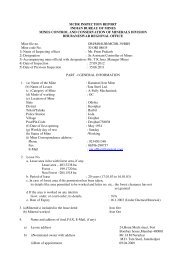Market Survey on Copper - Indian Bureau of Mines
Market Survey on Copper - Indian Bureau of Mines
Market Survey on Copper - Indian Bureau of Mines
Create successful ePaper yourself
Turn your PDF publications into a flip-book with our unique Google optimized e-Paper software.
The end-use <strong>of</strong> copper is determined by its chemical, physical, electrical,<br />
mechanical properties, etc. The major industries where copper is used are as follows:<br />
1. Electrical industry as wires, cables etc.<br />
2. Industrial and engineering applicati<strong>on</strong>s<br />
3. Building and c<strong>on</strong>structi<strong>on</strong><br />
4. Transport<br />
5. Coinage<br />
6. Ordnance & other uses<br />
7. Wrought copper & alloys<br />
8. <strong>Copper</strong> compounds<br />
9. Refrigerati<strong>on</strong> & Air C<strong>on</strong>diti<strong>on</strong>ing:<br />
2.1.1 Electrical Industry<br />
<strong>Copper</strong> is the best electrical c<strong>on</strong>ductor after silver as it encounters much less<br />
resistance compared with other comm<strong>on</strong>ly used metals. It sets the standard to<br />
which other c<strong>on</strong>ductors are compared. It is the single largest metal used in Electrical<br />
industry. Being good c<strong>on</strong>ductor <strong>of</strong> electricity, malleability, corrosi<strong>on</strong> resistance,<br />
ductility i.e. ability to be drawn as wires <strong>of</strong> varying thickness, copper is most sought<br />
after material for electric cables, both industrial as well as domestic. However, with<br />
aluminium and its alloys as well as cost difference, copper wires were substituted by<br />
aluminium specially in overhead power transmissi<strong>on</strong> lines, as well as underground<br />
cables.<br />
However, in household electrical fittings, power generati<strong>on</strong> and electric motor<br />
winding, copper is the most preferred material.<br />
Use <strong>of</strong> copper in cables and wire industry vary from c<strong>on</strong>tinent to c<strong>on</strong>tinent. In<br />
Asia, the share <strong>of</strong> electrical and electr<strong>on</strong>ics products is 50% while in USA it is 25%,<br />
whereas world wide the c<strong>on</strong>sumpti<strong>on</strong> in electrical industry is 17%. As per Planning<br />
Commissi<strong>on</strong>, the share <strong>of</strong> electrical industries in total c<strong>on</strong>sumpti<strong>on</strong> is <strong>on</strong>ly 39% while<br />
as per ICRA, the c<strong>on</strong>sumpti<strong>on</strong> in electrical industry is 26%.<br />
<strong>Copper</strong> is used for high grade copper wire cable used in the transmissi<strong>on</strong> <strong>of</strong><br />
electrical power and in telecommunicati<strong>on</strong>, motor and generator windings and in<br />
industrial, commercial and domestic electrical machinery and appliances.<br />
2.1.2 Power Cable and Wire<br />
Power cables and wires are the carriers <strong>of</strong> electricity from electric source<br />
to user equipment. Cables <strong>of</strong> varying thickness and types are used to carry out<br />
heavy current load from <strong>on</strong>e point to another, mostly underground. The wires<br />
used in various applicati<strong>on</strong>s are <strong>of</strong> lesser thickness. Wires are used as winding<br />
wires in electric motors as well as domestic electrical fittings.<br />
<strong>Copper</strong> c<strong>on</strong>sumpti<strong>on</strong> in electrical power has competiti<strong>on</strong> from<br />
aluminium. Aluminium has lower volume c<strong>on</strong>ducti<strong>on</strong> than copper (about 63%<br />
<strong>of</strong> copper) but a much lower density (about 30% <strong>of</strong> copper). Therefore for a<br />
7
















